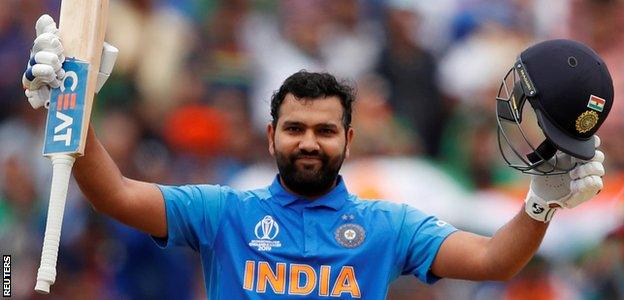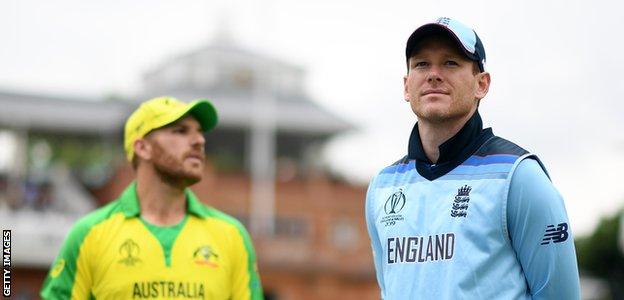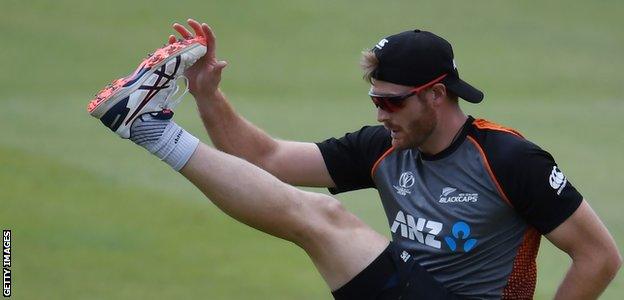Cricket World Cup semi-finals: Andy Zaltzman's guide
- Published

India face New Zealand at Old Trafford on Tuesday, with Australia meeting England at Edgbaston on Thursday
World Cup semi-finals (India v New Zealand and England v Australia) |
|---|
Coverage: Watch in-play clips & highlights on the BBC Sport website & app; live Test Match Special radio and text commentary on BBC Radio 5 Live sports extra & BBC Sport website |
In the grand modern tradition of sporting articles highlighting the blindingly obvious, here is my guide to the key phases of the Cricket World Cup semi-finals. With added numbers.
Key phase one: The beginning
You do not need to be a rocket statistician to know that starting your innings well in a cricket match is, broadly speaking, a good idea.
Successful opening partnerships have been strikingly influential in this World Cup.
In 41 completed matches, the side batting first has added 50 or more for the first wicket 17 times - and ended up winning 16 of those games (Afghanistan's 66-run opening stand against New Zealand - the 16th best opening score by a team batting first - was the exception). They have lost 13 of 24 when losing a wicket before reaching 50.
Chasing teams have won six of eight when they have added 50 for the first wicket, and lost 25 of 33 when they have not. The average opening stand for winning teams this tournament has been 70.2; for losing teams, 20.1.
For comparison, in between the last World Cup and this one - all stats for this period refer only to games between the 10 teams who have played in this tournament - the average first-wicket stand for winning teams was 53.4, and for losing teams, 28.2.
Teams with 50-plus opening stands batting first won 117, and lost 51. A good start has been considerably more influential in this World Cup than in recent one-day international cricket in general.
The semi-finalists highlight the importance of starting well. Australia safely negotiated the first 10 overs in six of their first seven games, before losing two wickets in each of their final two.
England lost no wickets four times and one wicket twice, and went on to win all six of those games. In their three defeats, they lost two in the first 10 against Pakistan and Sri Lanka, then three against Australia.
India have lost just four wickets in eight matches inside the opening powerplay. When batting first, they have scored 352, 336, and 314 after 10 overs with their first wicket still intact.
When they lost a wicket in the first 10 batting first, they managed scores of 268 and 224. Until their rapid start in their final game against Sir Lanka, India had been the second-slowest-scoring team in the opening powerplay, but the most secure.

India opener Rohit Sharma hit five centuries in the group stages - New Zealand might want to get him out early in the semi-final
New Zealand have bucked the trend somewhat in their early run of low-scoring victories. They have been the second least competent side with the bat in the first 10 overs of innings, losing 13 wickets in their eight innings (only West Indies equalled that tally). They lost at least one wicket in seven of their matches.
The only times they did not lose an opening-powerplay wicket were in the two games that propelled them into the semi-finals - their 10-wicket clouting of Sri Lanka on the first weekend of the tournament, and their crucial-point-acquiring abandoned game against India, when rain deprived them of the chance to bat disappointingly at the top of the innings.
With the ball, India have been the tightest bowling team in the first 10 overs - 3.90 per over. Their only defeat came in one of the only two matches in which they did not take a wicket inside 10 overs.
Australia won all six matches in which they took at least one wicket in the first 10; and lost two of three when they took none. England lost both games in which they failed to strike early; and won six of seven when they did.
Overall, it has never been harder to take early wickets in a World Cup. This tournament, all teams collectively have averaged 43.9 for opening partnerships.
In 2015, it was 30.7. In 2011, it was 34.1. For the three tournaments before then, it was between 28 and 30.
In other words, early wickets are important. You can have that one. My shout.
Key phase two: The middle

Mitchell Starc is Australia's key get-them-out-in-the-middle-overs man
Having started well, most strategists concur that your best plan is then to continue playing well.
With the ball, the four semi-finalists are well clear of the rest in the table of wickets taken from overs 11 to 40 - Australia 44 in nine innings; England 40 in nine; India and New Zealand 38 in 8. Next on the list is South Africa (32 in 8).
The other five eliminated teams each averaged below 3.4 middle-over wickets per innings.
The semi-finalists also lost the fewest middle-over wickets when batting - Australia, England and New Zealand exactly three per innings, India 21 in 8. The other sides averaged at least 3.3 middle-over wickets lost per innings.
A nine-matches-per-team group stage, in which several matches were lost to rain, is a relatively small sample size for ODI statistics.
It is notable, however, that the semi-finalists do not all stand out statistically in the opening and closing powerplays, but have been the four best wicket-takers and wicket-preservers in the unglamorous middle overs.
Key phase three: The end

"Hey, Woody. Andy Zaltzman says we're particularly effective in the death overs. Nice work, partner."
Ending well might not always be an option when it comes to life in general, but it is a considerable help in ODI cricket.
England (8.74 per over), Australia (8.37) and India (7.88) have been the first, second and fourth fastest-scoring teams in the death overs.
The four semi-finalists have all been in the top five most economical with the ball, with England (6.27) leading the table.
England's power with the bat, aside from their two-match chase-induced wobble against Sri Lanka and Australia, was expected.
Their death-over excellence with the ball - they also have the best team bowling average (15.9 runs per wicket) in the last 10 overs - has been a significant bonus, with Archer and Wood particularly effective.
Over the previous four years, England's bowlers had had only the eighth best economy rate in the final 10 overs (7.71), and seventh best average (23.9).
There are, aside from these three absolutely key phases, which could each be key to the key task of winning the key matches, the following key subsidiary phases:
Key phase zero: The pre-beginning

If you practise the coin toss, does it improve your chances?
Winning the toss is a good plan. Teams batting first have won 16 of the past 20 matches (having won 11 of the first 21 completed games).
Almost all of these victories have been of the higher-ranked team against lower-ranked opposition, so we might be reading too much into the bald numbers - but, even so, it has become barely conceivable that a team would choose to chase.
The recent run of results is another bucking of the pre-tournament trend.
In between the last World Cup and this one, the side batting first won 46% (142 out of 306 completed matches, with three ties and 161 defeats).
In England, that figure was 37% (19 wins, 1 tie, 31 defeats).
Key phase -1: The past

Martin Guptill is nicknamed Marty Two Toes after he lost three toes in a forklift truck accident at the age of 13
The past has proved absolutely critical for New Zealand, who roared into the semi-finals like a half-eaten kebab into a food waste bin on a Saturday morning.
They find themselves two matches from glory - unlikely, but not inconceivable given a couple of waspish Boult opening spells, some Ferguson middle-over pace mayhem, a belated Guptill clonk - thanks to two results from five weeks ago that irredeemably shunted the (unfit for purpose) net run-rate calculations in their favour, and an unfortunate/magnificent (delete according to level of New Zealand-ness) bout of bad weather soon after that skewed the entire tournament.
Has any team in any sport ever (a) gone into a semi-final in worse form, after three defeats, including two stodgy surrenders with the bat; or (b) so obviously set themselves up for a sensational against-the-odds, no-one-gave-them-a-chance phoenixing from some very unimpressive ashes?
Keyest key phase: Key phase two - the key middle overs

"Hopefully England go well in the middle overs against Australia, Beyonce..."
Obviously, a team's innings needs a good beginning, middle, and end. Like a novel. Or a train. Or a meal. Or a shark. Or major surgery. Or a celebrity marriage. Or a space mission. Especially a space mission.
The middle overs have been especially influential this tournament.
The ability to maintain and resist pressure in the central chunks of the knockout matches may well prove to be the decisive factor in determining who gets to (a) have the crowning moment of their career interrupted by an unnecessary blast of ear-bleeding pop music; and (b) lift the trophy.
Or it might be an early clatter of wickets. Or a pyrotechnic final 10 overs. Or a ridiculous run-out, a physics-defying catch, an opportune fluke, a great player touching greatness at the vital moment, a journeyman squad member Grant Elliotting his way to knock-out immortality. Or the random will of Zeus.
Or, most likely, a combination of the above. Thanks be to sport. Amen.